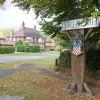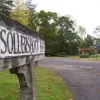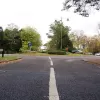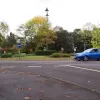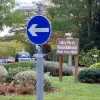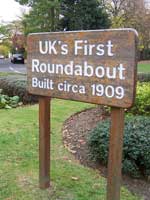
What an odd idea. Where several roads cross, with all the conflicting traffic movements and confusion that follows, who would ever think that the answer might be to makeeveryone give way to other traffic and to make everyone go out of their way to reach their desired road? And why, in particular, would you want to take all those different flows of traffic and choreograph them into an eccentric whirlpool of moving vehicles before letting them escape the junction?
Somehow, it works - and it was one of the earliest methods of modern traffic control to be devised. Whether it has been perfected yet is another question entirely, but it's clear that the concept of taking many conflicting strands of traffic and combining them so they all follow the same merry-go-round to reach their exit point, is a good one. Rarely has this eccentric system seen such enthusiastic application as here in the UK.
2009 marks the centenary of the UK's very first rotary junction, which makes the ideal opportunity to explore and enjoy the peculiar British obsession with the humble roundabout.
Things in the middle of junctions
It is nothing new to put something in the middle of a junction. It's been happening for millennia: the Romans were no strangers to busy cities and they were also well versed in the pleasing aesthetic possibilities of putting a statue or decorative column at a major crossroads. Traffic would go around that central point and that is, after all, a key part of any roundabout.
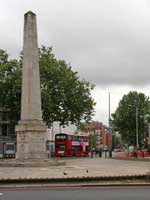
Over time the object in the middle started to grow out of a simple crossroads and began to require a re-shaped junction around it. The Arc de Triomphe in Paris, for example, is an enormous monument at the meeting point of twelve grand boulevards, the centrepiece of Baron Haussmann's masterplan for the city. The structure is so large that the roadway around it is, very obviously, circular. A roundabout? Well, not really.
Until the early twentieth century, things in the middle of junctions were just that: an object of civic pride placed where everyone would see it. St George's Circus in London (left; click to enlarge) is a circular open space - as many important junctions were - at the meeting point of several roads, hence the term circus. It was created in 1812 as the meeting point of several new roads linking to river bridges.
In 1905 a grand clocktower was built as its centrepiece - the beginnings of a roundabout, you might think, except that it was demolished in the 1930s as a "nuisance to traffic". The junction later became, of course, a roundabout - but certainly not just by accident of it having some architectural folly in the middle.
The roundabout is born
The birthplace of the roundabout is quite unexpected, because it's in a country that has only begun to experiment with building them in the last decade, and whose motorists still think of them as peculiar foreign devices. Happily, the junction claimed to be the first true roundabout still exists, at the intersection of 8th Avenue and Broadway in New York, at the south-west corner of Central Park.
Created as a focal point on the perimeter of the park, it was opened in 1905 as a circular open space with a statue of Columbus at its centre. It sounds for all the world like just another thing in a junction, except that this one was designed by William P Eno, a man known for pioneering ideas in road safety, and that it was described almost from the beginning as a "traffic circle". Without a doubt it had been designed to look pleasant at an important gateway to Central Park. But it was also, for the first time anywhere in the world, a circular junction with a central island that was designed to facilitate the movement of road traffic.
Columbus Circle is a major landmark in New York and its statue is the point from which distances to the city are measured. The first roundabout in the UK followed just four years later but was an altogether more low-key affair: a six-way junction in the southern part of Letchworth Garden City in Hertfordshire called Sollershott Circus.
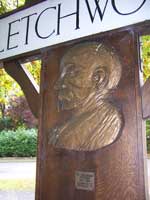
Unlike New York, London and Paris, Letchworth had no traffic problems and its roundabout did not connect major roads. The town is, even today, not a very built up place, with big houses well hidden down leafy avenues. But the Garden City movement that created it, led by the town's founder Ebenezer Howard (shown left; click to enlarge), was given to forward-thinking ideas in town planning and when it came to a point where six roads intersected they tried something new.
The six approaching roads were not to meet directly, and would instead all terminate at a circular roadway about 108 ft (33 m) in diameter. There was no centrepiece beyond a grassy circular island, so this was not a case of locating a civic ornament. It was traffic engineering, plain and simple, with the intention that a pedestrian could cross from any side of any street, to any other side of any other street, without having to cross the road more than twice.
With no one-way rule and no traffic priority it wasn't exactly a roundabout as we now know them - but this was 1909, when the UK had a national speed limit of 20mph and Henry Ford had only been in business for six years. Given the enormous changes the road system has seen in the intervening time, it's incredible that Sollershott Circus was recognisably a modern roundabout from the outset: a junction with a circular roadway, designed specifically to control the flow of traffic and improve road safety. A hundred years later, it is still doing its job.
A pilgrimage to Letchworth
No discussion of the UK's original roundabout would be complete without a visit to the sacred site itself.
Letchworth is a sleepy sort of place - rather like an overgrown village, full of overhanging trees and rambling houses, but with a ruthlessly organised and rigid street network.
Its through routes are really avenues, designed with rows of trees marching away to a distant focal point. This one - Broadway - is the main approach to the town centre from the south, and in the distance is an impressive fountain in the town's central square.
Where Broadway meets two other roads - Spring Road, Sollershott East and Sollershott West - the six-way junction was considered unusual and unwieldy enough by early twentieth century planners that it required something radical: a roundabout.
Here it is, seen from Spring Road: Sollershott Circus. Initially a glorified traffic island, it is barely modified from its original appearance - apart from some more ambitious gardening work in the centre - and yet it is very obviously a modern roundabout.
None of the roads here are particularly busy, which is just as well because the geometry of the junction is a little crude by modern standards. The entrance and exit points all require sharpish turns onto the roundabout itself.
So much for the development of the physical roundabout itself. A circular roadway and a central island doesn't quite complete the job, and it would take the rest of the twentieth century to perfect the priority rules, regulations, layout and geometry that make the junction we know today.
Picture credits
- Photograph of Columbus Circle taken from an original made available by the Library of Congress with no known rights restrictions.
- Photograph of St George's Circus taken from an original image by Martin Addison, used under Creative Commons Attribution-Share Alike 2.0 licence.

